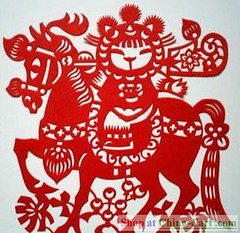| Home > Living in China > Custom |
Presenting Hada-an Etiquette to Show Hospitality
Presenting hada

Hada is a long piece of silk fabric used by the Tibetans and some Mongols as gift when greeting people, worshipping celestial beings, and in daily person-to-person contacts.
According to literal record, hada was invented by the Han people before it found its way to Tibet. During the Yuan Dynasty, when the Tibetan Sakya King, Phags-pa, returned to Tibetan after meeting Hublai, the founding emperor of the Yuan Dynasty, he brought a piece of hada that was inscribed with parrerns of the Great Wall on both ends and the four Chinese characters that mean "good luck".
Hada is of different lengths, but generally it is 2 metres long and 30cm wide. Most Hada is white which means purity. Red, yellow and light blue hada are made of fine silk fabrics and embroidered with Buddhist statues, Sanskrit messages, lotus flower and auspicious clouds, used on occasion of the highest grade.
When worshiping Buddhist statues, greeting or bidding farewell to friends, or holding weddings or funerals, the Tiberans show their respects and affection to their friends or beloved ones with hada.
The Tibetans are very etiquette conscious when presenting hada. When the recipient is an elderly, they would bend their body and hold hada above their head before presenting it to the recipient's seat or feet. When a hada is presented to the younger's neck, and the youngster is supposed to bend his body to show gratitude.
Art
 more
moreOrigin and Development of
Chinese paper-cuts As one of the most popular folk

History and Classification of
Erhu One of the most important aspects of Chinese

Chinese Calligraphy-an Amazing
Chinese calligraphy Chinese calligraphy is an

Customs
 more
moreChinese Kungfu
Training Method of Wing Chun Kung Fu
Wing Chun Practice In most martial arts schools,
An Introduction to the Chen-style Tai Chi Quan
Today tai chi chuan is typically practised for a number of widely
Four Widely-used Weapons
The four major weapons - sabre, spear, sword and cudgel - have been




 print
print  email
email  Favorite
Favorite  Transtlate
Transtlate 